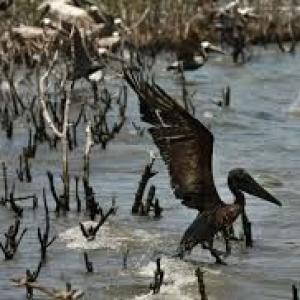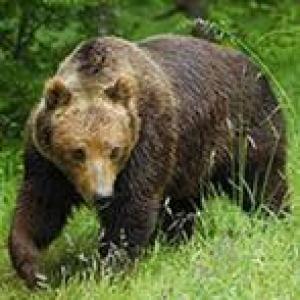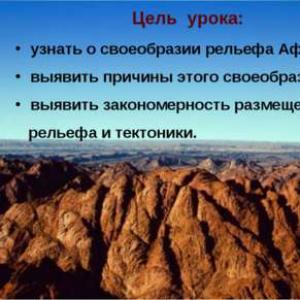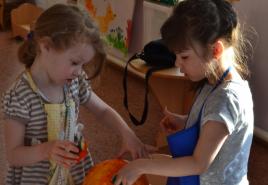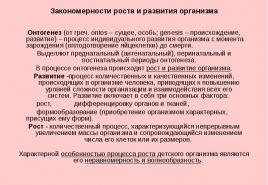Post 3 development and reproduction of animals. Summary of the lesson on the subject "The world around" on the topic "Development and reproduction of animals" (grade 3)
Lesson summary
around the world
Theme:
Development and reproduction of animals
Teacher: Zyuganova Elena Nikolaevna
Theme: "Development and reproduction of animals"
Goal: get acquainted with the peculiarities of the development and reproduction of animals
Tasks: to form universal educational actions within the lesson
Personal UUD:
Formation of a holistic, socially oriented view of the world in its organic unity and diversity of nature;
In the proposed situations, relying on the general rules of behavior for all, make a choice, what act to commit;
Ability to define one's attitude to the world.
Regulatory UUD:
Independently formulate the objectives of the lesson after preliminary discussion;
Together with the teacher, identify and formulate an educational problem;
Draw up a plan for solving the problem (task) together with the teacher;
Working according to the plan, check your actions against the goal and, if necessary, correct mistakes with the help of a teacher.
Cognitive UUD:
1. General educational universal actions:
Formulation of the topic of the lesson;
Search and selection of the necessary information (work in groups with text and illustrations of the textbook, visual aids);
Ability to adequately, consciously and voluntarily build a speech utterance in oral form;
Semantic reading as understanding the purpose of reading.
2.Universal logical actions:
Analysis of objects in order to highlight essential features;
Synthesis as composing a whole from parts;
Selection of bases for comparison;
Summing up concepts, object recognition;
Establishing causal relationships, building a logical chain of reasoning, evidence;
Putting hypotheses.
3. Statement and solution of the problem:
Independent creation of algorithms of activity when solving search problems.
Communicative UUD:
Ability to listen and engage in dialogue;
Participate in a collective discussion of problems;
Integrate into a peer group and build productive interaction and collaboration with peers
The main methods and technologies for the development of UUD used in the lesson:
technology of problem-dialogic learning
productive reading technology
technology for assessing educational success
group technology
Equipment:textbook, tables, pictures, presentation.
1. Organizational moment.
2. Checking d / z
List the names of the spring months in order. (March April May.)
What changes occur in nature with the arrival of spring.
Spring changes in nature
3. Knowledge update.
Spring also brings changes to animal life.
Let's remember in what main groups scientists group animals. (Insects, fish, birds, reptiles, amphibians, mammals. And also worms, mollusks, arachnids, crustaceans.)
Slide 2
And in what groups can animals be grouped, given what they eat? (Herbivorous, carnivorous, omnivorous.)
- Give examples.
Slide 3
In what groups can animals be united according to their ability to live and reproduce in captivity? (Wild and domestic animals.)
Slide 4
And my next question will lead us to a new topic. Let's try, recalling the previous material, to answer the question: into which groups can animals be divided, taking into account the methods of reproduction? (Oviparous; animals that spawn in water; viviparous.)
Slide 5
4. Creating a problem situation
I see that you are ready to discover new knowledge. Do you think we know everything about the group of animals, and their representatives? And write what the animals are called cubs. Slide 6
The fox has - ... (fox cub)
The duck - ... (duckling)
The butterfly - ... (caterpillar)
The fish - ... (fry)
At the grasshopper - ... (larva)
The snake - ... (snake)
(not entirely accurate, if you don't know, leave a place)
Guys, who was the frog in childhood? And the crocodile? Snake?
Why did we get different answers?
You see, we don't know everything about animal groups.
Have you already guessed what we are going to study today?
What do you want to learn in today's lesson?
5. Topic message
Animals, like all other living things, reproduce. Today we will talk about what features of reproduction and development are characteristic of different groups of animals.
Formulate the topic of the lesson? Slide 7
Formulate the objectives of the lesson. Ask questions. Slide 8
1.How do insects breed?
2.How do fish breed?
3.How will fish, amphibians, reptiles reproduce?
4. How do birds breed?
5. How do animals breed?
6. Discovery of new knowledge by children.
1) Teamwork on the textbook p. 73
- Which animals lay eggs? -Insects, reptiles, birds
Which animals spawn? -Fish, amphibians.
How does animal reproduction differ from other animals? -Beasts give birth to young
Reproduction and development of mammals: BABY - ADULT ANIMAL Slide 9
2) Group work Slide 10 -14
You will study the development and reproduction of animals in your group using the example of your representative.
1group
Insects
2group
Group 3
Amphibians
4 group
Reptiles
5 group
Read a scientific and educational text. Highlight the milestones in your animal's development. And with the help of pictures and words, draw up a scheme for the reproduction and development of an animal. At the end of the work, select a speaker.
Reproduction and development of insects: Slide 10
Option 1 - compose the development of a butterfly; Option 2 - the development of a grasshopper
EGG - Grub (Caterpillar) - PUPPET - ADULT INSECT;
EGG - LARVE - ADULT INSECT
Reproduction and development of fish: Slide 11
CAVIAR LITTLE ADULT FISH
Reproduction and development of amphibians: Slide 12
Caviar - tadpole - frog.
Reproduction and development of reptiles: Slide 13
EGGS - CHILDREN - ADULT
Reproduction and development of birds: Slide 14
EGG - CHILD - ADULT BIRD
7. Consolidation of the learned
Blitz survey.Slide 15
What is the name of the butterfly larva? (Caterpillar.)
Who develops from the fish larva? (Malok.)
What are the similarities between bird and insect reproduction? (They lay eggs.)
What are the similarities between the reproduction of birds and mammals? (Take care of the offspring.)
What conclusion can be drawn about animal reproduction? Slide 16
(Animals give birth to cubs and feed them with milk. But most other animals lay eggs and eggs. In birds, chicks emerge from eggs, in insects, larvae. In fish, fry emerge from eggs, in frogs and toads, tadpoles. adults.)
8. Lesson summary. Relaxation.Slide 17
What new did you learn in the lesson?
Now raise green cards those guys who understood everything during the lesson, red - if in the lesson nothing was clear at all.
application








Baby bear cub



Python snake eggs



Chicken eggs chicken




Eggs caterpillar chrysalis butterfly



Roe tadpole frog


Caviar fry crucian
Group cards.
1group. Insects
Read the scientific and informative text in the textbook on page 78. Highlight the main stages of development of your animal. Using pictures and words, draw up a scheme for the reproduction and development of an animal. At the end of the work, select a speaker.
Group 2. Fish
Read the scientific and informative text in the textbook on page 76. Highlight the main stages of development of your animal. Using pictures and words, draw up a scheme for the reproduction and development of an animal. At the end of the work, select a speaker.
Group 3.Amphibians.
Read the scientific and informative text in the textbook on page 77. Highlight the main stages of development of your animal. Using pictures and words, draw up a scheme for the reproduction and development of an animal. At the end of the work, select a speaker.
Group 4. Reptiles.
Read a scientific and educational text see Attachment... Highlight the milestones in your animal's development. Using pictures and words, draw up a scheme for the reproduction and development of an animal. At the end of the work, select a speaker.
5 group. Birds.
Read the scientific and informative text in the textbook on pages 74 -75. Highlight the milestones in your animal's development. Using pictures and words, draw up a scheme for the reproduction and development of an animal. At the end of the work, select a speaker.
Application.
Turtles - a detachment of reptiles that have existed for 250 million years, living both in water and on land. All modern turtles known to science are oviparous animals. Females lay eggs in a pitcher-shaped hole, which they dig with their hind paws (some - in their own living holes (gopher) or in crocodile nests), wetting the soil with the liquid sprayed from the body. Then the hole is filled up and tamped from above by blows of the plastron. Eggs are spherical or elliptical, white in color, usually covered with a hard calcareous shell. Only in sea turtles and some side-necked turtles do eggs have a soft leathery shell. The number of eggs laid varies from one to two hundred in different species.
Lizards... Most species of lizards are oviparous, some are ovoviviparous. In this case, the mother animal does not lay eggs or eggs, but bears them inside itself. Cubs leave the egg shell while still in the mother's body and are born after that.
Most lizards lay eggs. Usually eggs have a thin leathery shell, less often (mainly in geckos) - dense, calcareous. The number of eggs in different species is different and can range from 1-2 to several dozen. The female lays eggs one or several times during the year, in the most diverse, but always secluded places - in holes, cracks, under stones and driftwood, in tree hollows, etc. Some geckos glue eggs to the trunks and branches of trees, in places outcrops of rocks, etc. In most cases, after laying eggs, lizards no longer return to them. Only a few of them show concern for their offspring. Among our lizards, this is the yellow jellyfish. Females of this species not only guard the clutch, but also take care of it - periodically turn it over, clean it of debris.
For some time after hatching, females continue to protect them and even concede food.
One of the forms of caring for the offspring can be attributed to the ability of some lizards to delay the laying of eggs, waiting for the onset of favorable conditions for this. So, in a quick lizard, egg laying can be delayed for 20 days. In others, for example, in a viviparous lizard, up to hatching.
One of the causes of live birth is the cold climate. It is interesting that even lizards of the same species, depending on the height of their habitat above sea level, can either lay eggs or give birth to live cubs.
Different types of snakes reproduce in different ways. For example, rattlesnakes, copperheads, water snakes do not lay eggs, but give birth to live cubs. Snakes are known that can give birth to up to 75 cubs at a time. Other snakes lay eggs. They usually do this in secluded places, under stones, under logs, or in empty stumps. In shape, snake eggs are somewhat different from chicken eggs: they are smaller and more authentic. Although the eggs of large snakes may not be inferior in size to chicken ones.
The shell of a snake egg is strong enough, resembling a skin. The number of eggs in a clutch varies depending on the type of snake. The python lays the most eggs. The Indian python can lay up to 107 eggs at a time.
The eggs are usually kept in the sun or in the heat generated by rotting vegetation. Sometimes snakes guard the eggs, coiled around them in a ring.
But who cares about the growing offspring if the number of eggs in a clutch reaches 100? Nobody! All small snakes are able to take care of themselves from the moment they are born.
Due to the extremely high level of their existence and structure, several types of reproduction and postembryonic development were formed, which transmit genes to the offspring and continue to ensure the survival of the species.
The reproduction process is one of the important properties of organisms and is divided into two ways: asexual and sexual.
The sexual method is used by animals with a complex body structure, such as crustaceans, and, basically, all vertebrates.
Animals have two mechanisms of fertilization: external and internal.
External fertilization
One of them is external fertilization, in which eggs and sperm are fused outside the animal's body. For example, fish and amphibians use this method of fertilization. This type of fertilization is called spawning and takes place in the aquatic environment. Accordingly, sperm needs water to swim up to the eggs laid, and the eggs, in turn, need water to prevent drying out. Most aquatic invertebrates, most fish and some amphibians use external fertilization. These animals release large quantities of sperm and eggs as they suffer significant losses of gametes in the water. Therefore, fish simply need to spawn a large amount of eggs. Thus, female perch lays 200-300 thousand eggs, and female cod - up to 10 million. In addition, courtship behavior in some species leads to the simultaneous release of gametes, which helps to provide the egg with sperm.
Gametes, or sex cells, - reproductive cells that have a haploid (single) set of chromosomes and participate in gamete, in particular sexual, reproduction. When two gametes merge in the sexual process, a zygote is formed, which develops into an individual (or a group of individuals) with hereditary characteristics of both parental organisms that produced gametes. Wikipedia
Paying attention to breeding goldfish it should be noted that there are same-sex populations (usually there are no males). The development of eggs of this species occurs after the sperm of a completely different species of fish (carp, goldfish, tench) penetrates into them. But at the same time, standard fertilization does not occur. In this case, the sperm is only an irritant that awakens the egg to development.

This type of external fertilization, or rather spawning, also includes seahorses. They, like no one else, bewitchingly romantically mate and dance until the female puts her eggs in a special pouch of the male. It turns out that the seahorse is a conscious male that becomes pregnant and carries his offspring. After the male gives birth, he leaves his young to develop and take care of themselves.
Internal fertilization
Another example of sexual reproduction is internal fertilizationin which the male injects sperm into the female's reproductive tract, where the eggs are fertilized. This fertilization is an adaptation to life on land, as it reduces the loss of gametes that occurs during external fertilization. Sperm are supplied with a fluid (sperm) that provides a watery environment inside the male's body. Mating and reproductive readiness are coordinated and controlled by hormones, so sperm and egg cells are combined at the appropriate time.

After internal fertilization, most reptiles and all lay eggs, which are surrounded by a rigid membrane or shell. Their eggs have four membranes: amnion, allantois, yolk sac, and chorion. The amnion contains the fluid surrounding the embryo; allantois stores the embryo's urinary waste and contains blood vessels that bring oxygen to the embryos and take carbon dioxide away. The gall sac holds the congested food, and the chorion surrounds the embryo and other membranes. In birds and reptiles, the embryo matures outside the body and is protected by a membrane.
Basically everyone (cows, yaks, hippos, rabbits, dogs and many others) uses internal fertilization, but there are exceptions - such as and, which lay eggs.
Sexual reproduction has its "pluses": the formed individuals carry the characteristics of both parents and this species of animals will not disappear; they adapt better to their environment.
Among animals also occurs parthenogenesis- This is a single form of sexual reproduction, during which the embryo develops from one reproductive cell without any fertilization. Such reproduction is usually inherent in insects, some crustaceans and worms.
Asexual reproduction Is a process in which the next generation develops from somatic cells without the participation of reproductive cells - gametes. Such reproduction is usually used in less complex organisms.
For example, an amoeba is divided into two parts. This type of asexual reproduction is called binary fission. This is a very fast and effective way for bacteria and similar cell types to create offspring.
Dissolved animals
There are many dioecious animals... But among the lower there are many such species that have both the sex glands of both the male and the female. These animals are called hermaphrodites. These include many flatworms: liver flukes, bovine tapeworms, pork tapeworms, and others.
After fertilization, a series of developmental stages occurs during which the primary embryonic layers are established and reorganized to form the embryo. During this process, animal tissues begin to specialize and organize into organs and organ systems, determining their future morphology and physiology.
Development Is a process of formation of an organism, closely related to growth. There are two types of animal development: direct and indirect, or with reincarnation.
Direct type of development - This is the development of daughter organisms very similar to adults. This includes arachnids, reptiles, birds, mammals, worms.
Indirect type of development - this is a development in which a larva is created, which differs from the body of an adult in both external and internal structure, the nature of movement, and feeding. These include insects, amphibians, and coelenterates. In the case of indirect development, larvae and adults live in different conditions and therefore do not compete with each other for territory and food. Due to this, the species can have a large number of individuals. For example, in butterflies, the larvae eat the leaves of plants, and the adults feed on the nectar of flowers. The toad larva feeds on algae, unicellular, and adult toads - on insects and their larvae. Accordingly, the indirect type of development gives the body significant advantages.
Each animal has its own life cycle with its own developmental phases. Exist plain and complex cycle... A complex life cycle is characterized by the alternation of generations (one generation of the liver fluke reproduces sexually, the other asexually) or is associated with the reincarnation of the organism. For example, grasshoppers have a simple cycle: egg - larva - adult insect. Butterflies have a complex life cycle: an egg - a larva - a pupa - an adult.

Bark beetle larva
Larvae often constitute a life stage that is used for feeding or dispersal. In many species, the larval stage is the longest, and the adult stage is the shortest stage solely for reproduction. For example, in silkworm moths, adults have no mouths and cannot feed. And the larvae must eat enough to survive and eventually mate. Indeed, most female moths, once they emerge from their pupa, fly only once to lay their eggs. Then they die.
Many animals have regeneration - renewal of lost body parts. The smallest part of the hydra can give rise to a new organism. Among chordates, regeneration is best developed in amphibians, slightly weaker in reptiles (they can renew fallen off tails). In other animals, this function remains at the level of wound healing.
Each animal has its own individual development with such stages:
- embryonic (from fertilization to birth);
- immature;
- adult sexually mature;
- aging and death.
Role of Homeobox (Hox) genes in animal development
Since the beginning of the 19th century, scientists have noted that many animals, from simple to complex, have similar embryonic morphology and development. Surprisingly, the human embryo and the frog embryo, at a certain stage of embryonic development, seem remarkably similar. For a long time, scientists did not understand why so many species of animals looked the same during embryonic development, but became completely different when they grew up. At the end of the 20th century, a certain class of genes was discovered that dictate the direction of development. These genes that determine the structure of animals are called "homeotic genes." They contain DNA sequences called homeoboxes with specific sequences called Hox genes. This family of genes is responsible for determining the overall body plan: the number
If you find an error, please select a piece of text and press Ctrl + Enter.
Development and reproduction of animals Prepared by: Primary school teacher MBOU "Shock school" Medvedeva V.M.

Domestic ones caress, and wild ones bite. They are everywhere and everywhere: on land, in the sky and in water, there are forest, swamp. We call them ... ANIMALS There are a lot of animals in nature, they are all different, but they can be divided into several groups according to common characteristics and habitat. insects fish amphibians reptiles birds mammals fish reptiles insects amphibians mammals birds

Guess who it is? I grow like a worm. I feed on a leaf, Then I fall asleep, I wrap myself, I don't eat, I don't look, I hang motionlessly, But in the warm spring I come to life again And, like a bird, I flutter. BUTTERFLY

Insects Butterfly Development The urticaria butterfly lays its eggs on the nettle. The eggs hatch into larvae. Butterfly larvae are called caterpillars. They are not at all like adult butterflies. Caterpillars feed on nettle leaves, grow quickly, and then turn into motionless pupae. A little time will pass, and a butterfly will appear from each pupa. yaya eggs egg caterpillar gugu larva pupa pupae a butterfly Adult insect

This is interesting. The caterpillar grows so fast that its skin is cracking, and underneath it is already new skin designed to grow. - Throughout her life, a female butterfly lays 50,000 eggs. - The butterfly does not grow, however, it likes to drink sweet flower nectar from time to time. It is the fuel that helps her fly.

In the meadows and on the edge, Among the green grass, Skillfully disguises the merry Longus! Chirping it, Often cuts ears, He does not trust anyone - Do you want it? And listen! Legs - long on the shoulders, Well! Learned? He is ... THE BLACKMIT

Grasshopper Development Not all insects have pupae. Grasshoppers do not have pupae. Their larvae are very similar to adult grasshoppers, only they are very small and do not have wings. Growing up, each larva sheds its skin several times. When this happens for the last time, an adult insect emerges from the skin - large and with wings. larva egg adult insect

I swim under the bridge And wag my tail. I don’t walk on the ground, I have a mouth, but I don’t speak, I have eyes, I don’t blink, I have wings, I don’t fly. Development of fish In spring, females spawn eggs into the water. Fry appears from the eggs, which are similar to adult fish, only very small. The fry feed, grow and become adult fish. fish fry roe

Interesting facts The blue whale is the largest animal on the planet. It can reach a length of 33 m and a mass of 150 tons. Cubs are born with a length of 6 to 8.8 m and a mass of 2-3 tons. Blue whales are found in almost all regions of the World Ocean.

Amphibians and reptiles Paws emerge from the fry - Long-legged children. In a puddle, a croak - Long-legged, jumps ... Development of frogs In spring, loud voices of frogs and toads are heard in a pond, river, lake - real concerts! Females of frogs and toads lay eggs in the water. After a few days, tadpoles emerge from the eggs, which are similar to small fish than to adult amphibians. Tadpoles live in water, feed, grow and transform into frogs and toads. roe tadpoles frog

Females of lizards, snakes, turtles, crocodiles lay eggs. Small lizards, snakes, turtles, crocodiles hatch from eggs. They grow and gradually develop into adult animals. Reproduction and development of eggs cubs Adult animal

Birds Almost all birds build nests in the spring. Birds lay eggs in the nests and incubate them - they warm them with their warmth. Chicks grow quickly and need a lot of food. In late spring and early summer, the chicks of many birds leave the nest. Although they are already covered with feathers, they still fly poorly. They cannot eat on their own either. Parents feed their chicks for some time and protect them from enemies. Reproduction and development of eggs Chicks Adult bird

This is interesting. The cuckoo does not build its nest and does not incubate the eggs that it has laid. And it puts them in the nests of other birds, usually singing. Sometimes the cuckoo manages to spread up to 20 of its eggs in other people's nests. The cuckoo tries to push other eggs and even small chicks out of the nest so that it gets more food. Soon, the small voracious cuckoo becomes larger than its adoptive parents, who are exhausted to feed the foundling.
Our planet is inhabited by a large number of a wide variety of animals that have adapted to life in different parts of the Earth. As a result of this diversity, the reproduction and development of animals also has many differences and characteristics.
Insects
Insects have males and females, which can vary in size and color. The female lays eggs and no longer cares about her offspring. She does not protect them from other animals, does not observe how larvae appear from eggs.
The larvae do not look like their parents at all. They are small and incredibly voracious creatures that feed heavily and grow in size.
After some time, a new period of development begins: the larvae turn into motionless pupae, which are attached to the plants in anticipation of their time. After the allotted time, a formed adult insect appears from the pupa, ready for a full life.
To leave offspring, the female and the male must meet each other. But how to do that? Many insects go for different tricks: they sing serenaded songs, glow like tiny lanterns, and emit strong odors.

Figure: 1. Praying mantises.
Fish, amphibians and reptiles
The reproduction and development of fish occurs in stages:
TOP-3 articleswho read along with this
- In the spring, females lay eggs, and the male fertilizes them.
- A tiny larva develops from each egg.
- Over time, the larva turns into fry.
- Malek, actively feeding, increases in size and turns into an adult.
Turtles, crocodiles, snakes, lizards lay eggs, from which small cubs are born, which outwardly do not differ from their parents, except in size.
There are two types of reproduction in nature - sexual and asexual reproduction. The first option is used by all animals with a complex body structure: mammals, birds, fish, insects, reptiles and amphibians. Asexual reproduction is characteristic of unicellular organisms, which form their own kind due to cell division.

Figure: 2. Baby turtle.
Birds
In the spring, many birds begin to build nests - this is how they prepare for the appearance of offspring. In nests, birds lay eggs, and then incubate them, warming them with the heat of their body.
After a while, young birds appear from the eggs - chicks. In some birds, they are active and inquisitive, and their body is covered with down, in others, chicks are born naked and completely helpless. But all without exception at first depend on parental care, since they cannot fly and independently obtain food for themselves.
To feed their insatiable babies, birds are forced from morning to evening to search for suitable food. However, such efforts quickly pay off - already at the beginning of summer, matured chicks of many birds leave their parental nests.
Mammals
Mammals or animals, unlike other animals, give birth to live young, and feed them with their milk. Until the kids get stronger and are not ready for adulthood, the parents take good care of them, protect them from enemies, and teach them how to get their own food. As a rule, all these functions lie on the shoulders of the mother, but there are mammals that raise their offspring together.
While the kids are helpless, they have many enemies. In order not to become easy prey, they hide in their home almost all the time. Cubs of foxes and badgers hide in deep burrows, squirrels are reliably hidden in a nest in a tree or in a hollow, the house of bears is a spacious den.

Figure: 3. Fox with cubs.
What have we learned?
When studying the program of the 3rd grade of the world around us, we learned what are the features of the development and reproduction of different representatives of the fauna. Each of them was able to adapt to the conditions in which he lives and raise his offspring. For some, babies are immediately born as small copies of their parents, while others have to go a long way of development from a tiny egg to an adult animal.
Test by topic
Assessment of the report
Average rating: 4.6. Total ratings received: 433.
Class: 3
Lesson presentation
Back forward
Attention! The slide preview is used for informational purposes only and may not represent all the presentation options. If you are interested in this work, please download the full version.
Class: 3.
Lesson objectives:
- To acquaint students with the peculiarities of the reproduction of animals of different groups.
- To form an idea of \u200b\u200bthe sequence of development of animals of different groups.
- During the lesson, curiosity, coherent speech develops; the ability to reason, observe, generalize, draw conclusions, and also work in pairs.
Equipment:
- A computer.
- Media projector.
- Power Point presentation.
- Development tables for representatives of different groups of animals.
During the classes
I. Communication of the topic of the lesson.
- We need a new shirt. What are we doing? (We buy a new shirt or sew it ourselves.)
- We need grass on the lawn in front of the house in the country. What are we doing? (We sow seeds, grow, water.)
- True, to get a new item, a person makes it from other materials. To get a new plant, we grow it: sow seeds, plant bulbs, bury tubers, take shoots, etc. (depending on the breeding method).
Animals, like all other living things, reproduce. Today we will talk about what features of reproduction and development are characteristic of different groups of animals.
II. Preparation for the perception of new material, repetition of what was previously learned.
- Let's remember in what main groups scientists group animals. (Insects, fish, birds, reptiles, amphibians, mammals. And also worms, mollusks, arachnids, crustaceans.)
- And in what groups can animals be grouped, given what they eat? (Herbivorous, carnivorous, omnivorous.)
- Give examples.
Slide 3- In what groups can animals be united according to their ability to live and reproduce in captivity? (Wild and domestic animals.)
- And my next question will lead us to a new topic. Let's try, recalling the previous material, to answer the question: into which groups can animals be divided, taking into account the methods of reproduction? (Oviparous; animals that spawn in water; viviparous.)
III. Learning new material: Reproduction and development of insects.
Slides 6-14- Insects have males and females. Thus, insects are dioecious inhabitants of our planet. Like most species of living creatures, males and females of insects have differences, which can be expressed, for example, in bright colors, in size - males are most often larger, but there are exceptions.
This is, of course, necessary so that the male and female can find each other. Different insects search in completely different ways. Someone sings serenaded songs, and someone shines like a small flashlight, like, for example, firefly bugs. Some insects give off odors, sometimes fragrant (rutabagas smell like lemon leaves), and sometimes not very pleasant for the human nose.
So, the female and the male found each other. The female laid eggs.
I think now it's time to find out how the further development of the future insect will take place.
I propose to conduct observations of a butterfly called admiral.
Having laid an egg on a leaf of a forage plant, the female no longer worries about the further fate of her offspring. She does not watch how the larva appears from the egg (in butterflies it is called a caterpillar). This is a very voracious creature that does not at all look like its parents. The caterpillar feeds heavily, grows and molts.
After a while, the next stage of development will come: the caterpillar will turn into a pupa. This is indeed a motionless pupa that attaches to the surface of the leaf and waits for the next stage - the appearance of an adult insect.
- So, let's create an insect development scheme using the example of the admiral butterfly. (Egg, caterpillar, pupa, adult insect.)
- It should be noted here that not all insects follow this path of development. Among the representatives of this group of animals, there are also those that do not have the pupal stage, and the larva looks like an adult insect. For example, these are grasshoppers and dragonflies.
IV. Learning new material: Reproduction and development of fish.
- To have an idea of \u200b\u200bthe reproduction and development of fish, let's take a closer look at the life of pink salmon. During the mating season, the color of the male pink salmon changes, the jaws become bent, and a hump grows on the back. At the same time, the female does not change.
The female spits eggs into the water, and the male waters her pier aboutkami. A larva can develop from each individual egg. A fry develops from the larva, and an adult fish develops from the fry.
Slides 15-19V. Learning new material: Practical work in pairs.
- Compare the larva, fry, adult salmon fish. Find similarities and differences.
Vi. Learning new material: Reproduction and development of birds.
- Let's, based on our life experience, try to draw up a chain of bird development. (Egg, chick, adult bird.)
- Well done! And here it is necessary to pay attention to the following features of the development of birds.
- All birds breed on land.
- Most birds build nests.
- Birds incubate eggs, warming them with the warmth of their body.
- Parents feed the chicks and protect them from enemies.
Vii. Learning new material: Reproduction and development of mammals.
- We just concluded that birds are a very interesting group of animals that take care of their offspring. What other group of animals cares about their offspring? (Mammals.)
- Correctly. Let's make a conclusion.
- Mammals give birth to live cubs.
- The mother feeds them with milk, looks after them, protects, teaches them to get food, to defend themselves from enemies.
VIII. Lesson summary.
- What is the name of the butterfly larva? (Caterpillar.)
- Who develops from the fish larva? (Malok.)
- What are the similarities between bird and insect reproduction? (They lay eggs.)
- What are the similarities between the reproduction of birds and mammals? (Take care of the offspring.)
Images used in the presentation are from.

